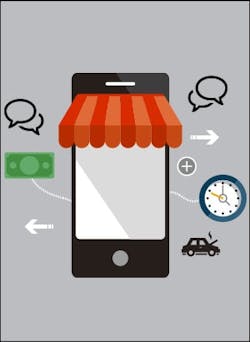A car breaks down. The owner is frustrated. The owner wonders what the problem could possibly be. The owner contemplates the cost of fixing that problem. The owner looks at the bank account. The owner sighs.
Finally, the owner decides to pick up the phone and call your shop … and is put on hold.
A survey conducted by text message service TalkTo revealed that 53 percent of American consumers spend 10–20 minutes on hold every week, adding up to 13 hours annually. And when customers call a business—especially if their car has broken down—they’re typically not in a good mood.
“When they come to us, it’s usually because the car has betrayed them, or they’re afraid that their car is going to betray them. It’s one of the two,” says Terry Keller, owner of Keller Bros. Auto Repair in Littleton, Colo., and CEO of Auto Profit Masters (APM), a consulting business for auto repair shops. “So how do you build trust with someone who doesn’t want to be in my repair shop?
“That’s really the question you need to ask at every step of the customer-shop relationship, for the quality of the repair, the quality of the people you have doing the repair, the training, their tools, the guys up front—are they well trained to build trust with the customer? It’s all pretty important, and an on-hold message is a small piece of that.”
So, when a customer is put on hold, what message should they hear? Why is that message so important psychologically? And how can that message help form a bond that potentially keeps that customer coming back for years to come?
Keller, who has built his shop into a $3.5 million powerhouse, uses a unique approach to his on-hold messages and has helped many other shops do the same through APM.
Leaving somebody on hold for too long is detrimental psychologically for the customer’s perception of the business. According to the TalkTo survey, customers are less and less likely to wait or find a customer service representative helpful the longer they’ve been put on hold.
What’s even worse for business? A customer basking in silence. A CNN survey showed 70 percent of callers put on hold in silence hang up within 60 seconds—of those lost customers, 35 percent won’t call back.
“There’s no excuse to leave them on hold for two or three minutes,” Keller says. “If you can’t get to them and take care of them, you need to take a message or you need to reprioritize whatever it is you’re doing.”
Keller says to use your own customer service experiences with other businesses as motivation. When a customer is put on hold, he or she is thinking about the bad experiences, inherently putting him or herself on defense. The longer they wait, the more frustrated and confrontational they’ll be.
Properly Brand Yourself
Keller can now look back on the days when he was a naïve, down-on-his-luck repair shop owner barely making it out of recession after recession. He scraped through four recessions out of pure luck, but the other two, he says, came from properly branding his business—especially through his on-hold message.
“My on-hold message was branding me to be viewed a certain way, and there was no thought put into that,” Keller says. “So the idea of branding to me today is to project to your customers who you are, what you can do for them, your ethics and the way you go about business.”
To begin to build trust with the customer, Keller says honesty is key. You have to present information about your business that is both quantifiable and sustainable. If you don’t? They call your bluff.
“You can’t say, for instance, “We’re the most honest and we’re the best,” says Keller. “That is not quantifiable and saying you’re the best is not sustainable. You can’t send a message that you’re the cheapest. You can’t sustain that. You can’t say anything that you cannot deliver 100 percent or that you cannot sustain. It violates trust. It does not build trust.”
“Educate,” Don’t “Sell”
Keller Bros. Auto Repair keeps a rotation of 15 different messages, which Keller says keeps the on-hold experience from feeling stale. And on each one of those 15 waits, Keller says he takes the opportunity to give the customer the necessary information about his shop.
“We don’t use the word ‘sell’ in our business,” Keller says. “We educate our customers. [For the on-hold message], I want to educate my customers about my hours of operation, the services I offer.”
And when it comes to services, Keller isn’t talking about oil changes, tune-ups and axle replacements—what can you offer the customer that sets you apart?
The customer wants to know how you will make his or her life easier, he says. Educate the customer on how you show you care or how you can help them get through a difficult, financially troubling time. That could mean free rides to and from work and home; free loaner cars; a three-year, 36,000-mile warranty on parts and labor; early bird and after-hour drop-offs; towing contacts. Instead of selling yourself and offering something unquantifiable, give the customer tangible information they can grasp and utilize.
“They’re calling in, they’re on hold, they’ve got soccer games for the kids this afternoon,” Keller says. “‘Oh, at Keller Bros., you can ask us anytime for a free ride to and from work or home. We also have free loaner cars.’ Boom. You just solved a big problem for them.”
Keller takes it even further: He promotes his shop’s support of local charities, the shop’s history in the community, and the various warranties the shop offers.
“Thank you for choosing Keller Bros. Auto Repair,” one of his 15 messages reads. “We want to take this opportunity to tell you that we are proud sponsors of Denver Rescue Mission. This organization has been an important part of our community for generations and we look forward to helping them continue their good work. For more information on Denver Rescue Mission and how they can help you or you help them, please stay on the line. We live here, we love it here, and we hope it shows.”
Coordinate the Communication Process
Say a customer calls your shop, is put on hold, and the message reads: “We’re the best, we’re the quickest, we’re the cheapest.”
From that point forward, that is the vision the customer has of your shop. They see a billboard advertising your business on the drive over; they pull up in the parking lot and examine your building; they walk into the lobby and are greeted by the front desk; they sit in the waiting area and observe the lobby; they look through the shop window at the technicians; they receive an estimate.
If any of the steps in the repair transaction don’t coincide with their original impression of the shop? You haven’t properly branded yourself—and the customer will know, says Keller.
“If they get on the phone and find something different, or they come in to the shop and find something different, is that going to build trust?” Keller asks. “It’s got to be consistent. It’s either going to build trust or hurt trust with the customer.”
Make It Unique to Your Shop
Keller doesn’t recommend using on-hold message services that provide general, generic messages for businesses.
“It’s better than the customer just sitting there and listening to nothing, but not much,” Keller says. “Customers are sophisticated today. It has to be the owner’s brand, what he’s about, what his attitude toward our customer is, and how he does business.”
Keller says that customers, psychologically, will tune out a message that’s broad, uninformative and uninteresting. The message should feature a voice with an engaging and friendly tone—essentially, what they can expect when they walk through the door.
The only component Keller says you should outsource is the accompanying music, which should be light, unobtrusive and never detract from the actual information being presented.
“There are plenty of companies out there that provide this type of service,” Keller says. “They’ll guide you through it and it’s very easy to implement.”
Have an After-Hours Message
If a car breaks down in the middle of the night, the customer’s anxiety reaches new levels. That’s why, Keller says, your after-hours message is as important as your on-hold recording during business hours.
An after-hours message should also include the hours of operation, and information about late-night or early-bird drop-offs. There should be no anecdotes—only information. Keller says it should be no more than 30 seconds long, and include the most important bit of information: which towing service a customer should call.
“If you need a tow, here’s the information,” Keller says the message should read. “My shop has a relationship with our tow company, so if one of my customers calls them, they are to jump on it, they are to get that car towed.
“They get their car taken care of, they get the customer a ride, they get them to rental car place—whatever it takes to take care of that customer. Because here’s the deal: When the customer calls and they need a tow, that’s when they really, really need us. And boy, we had better perform. We better be willing to go the extra mile.”

